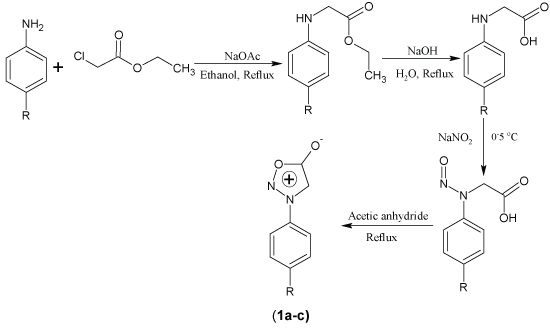
Scheme 1: The synthesis of sydnone 1a-1c.


Asma1 Balakrishna Kalluraya1* Manju N1 Chandra2 Mahendra M3 B C Revanasiddappa4
1Department of Studies in Chemistry, Mangalore University, Mangalagangothri, Karnataka, India*Corresponding author: Balakrishna Kalluraya, Department of Studies in Chemistry, Mangalore University, Mangalagangothri-574199, Karnataka, India, Tel: 9448824075; E-mail: bkalluraya@gmail.com
A novel series of 1-aryl-3,4-bis-(3-alkyl/phenyl-[1,2,4] triazolo[3,4-b][1,3,4]thiadiazol)-1H-pyrazole (5a-i) are synthesized by the cyclocondensation of 1-(aryl)-1H-pyrazol-3,4-dicarboxylic acids with 3-alkyl/aryl-4-amino-5-mercapto-1,2,4-triazoles. Pyrazole dicarboxylic acids were prepared by the 1, 3-dipolar cyclo addition of 3-aryl sydnones with dimethylacetylenedicarboxylate (DMAD). The newly synthesized compounds were studied for their antibacterial, antifungal and antioxidant activities. Particularly compounds 5a and 5g showed considerable antibacterial activity against the standard drug, while all the tested compounds displayed poor inhibitory effect against fungi. Compound 5d exhibited good antioxidant activity. The docking study was performed with Acinetobacter baumannii penicillinbinding protein target using AutoDock 4.2, which proved H-bond interaction and strong binding affinity.
Antimicrobial; Dipolar addition; Molecular docking; Pyrazole; Triazolothiadiazole
The present scenario in synthetic chemistry has been focused on designing new molecules by the lead hybridization-based synthesis of different pharmacophore fragments in a single molecule with improved biological efficacy.
Pyrazole derivatives have gained immense importance due to the variety of biological activities associated with them such as, antibacterial [1], antiviral [2], anticancer [3], anti-inflammatory [4], antidiabetic [5], anti-depressant [6], antioxidant [7], antitubercular [8], antihypertensive [9] etc. On the other hand, triazolothiadiazoles are reported to exhibit a broad spectrum of biological profile. They were found to possess antibacterial [10], analgesic [11], antitubercular, anticancer, anti-inflammatory and antimicrobial [12] activities.
Previous studies suggested that the presence of pyrazole and triazolothiadiazole pharmacophore plays an important role in the enhancement of pharmacological activity. Encouraged by these findings and aiming at synthesizing new hybrid molecules having enhanced biological properties [13,14], we herein report the synthesis of novel series of bis-1,2,4- triazolo[3,4-b]-1,3,4-thiadiazoles starting from aryl sydnones and their antibacterial, antifungal and antioxidant activity. Molecular docking study was also performed.
All the reagents and solvents were purchased from Sigma-Aldrich or Hi-Media and used after distillation/ recrystallization. 1H NMR spectra were recorded on Bruker Avance II NMR spectrometer operating at 400 MHz and all the chemical shift values were reported in parts per million (ppm) relative to tetramethylsilane (TMS). Mass spectra were acquired on a SHIMADZU LCMS-8030 mass spectrometer. Melting points of the synthesized compounds were determined in open capillary tubes in Innovative DTC-967A digital melting point apparatus. SHIMADZU FT-IR 157 spectrophotometer was used for recording IR spectra. C H N analysis was performed with Vario-EI Elementar-III model analyzer. In-silico study was done using Auto Dock 4.2.
3-Arylsydnones 1a-c (1 mmol) and DMAD (1 mmol) in 10 mL of dry xylene was refluxed in an oil bath at 120-125 ° C for 1 hr. After the completion of reaction, solvent was removed using rotary evaporator. The solid obtained was recrystallized from ethanol [15,16].
1-(Aryl)-1H-pyrazol-3,4-dimethyl carboxylate (1 mmol) and sodium hydroxide (2 mmol) were taken in aqueous alcohol (50 mL) and refluxed in an oil bath for 2 hrs. After cooling, the reaction mixture was acidified using hydrochloric acid (pH=2). The solid separated was filtered off and washed thoroughly with water. The dried product was recystallized from ethanol.
1-(p-Anisyl)-1H-pyrazol-3, 4-dicarboxylic acid (3a): White solid, Yield: 95%. M.P.: 204°C. Anal. calcd for C12H10N2O5 (%):C, 54.97; H, 3.84; N, 10.68; Found: C, 54.92; H,3.80; N,10.74. IR (KBr cm-1) 3426 (O-H), 1717 (C=O), 1244 (C-O); 1H NMR* (400 MHz, DMSO-d6) δ 3.81 (s, 3H, OCH3), 7.08- 7.10 (d, 2H, J=7 Hz, o-protons of p-anisyl), 7.83-7.86 (d, 2H, J=7 Hz, m-protons of p-anisyl), 8.98 (s, 1H, H of pyrazole ring). MS: m/z: 260.90 [M+-1].
1-(Phenyl)-1H-pyrazol-3, 4-dicarboxylic acid (3b): Colorless needles, Yield: 71%. M.P.: 235-236°C. Anal. calcd for C11H8N2O4 (%):C, 56.90; H, 3.47; N, 12.06; Found: C, 57.07; H, 3.58; N, 12.18. IR (KBr cm-1) 3427 (O-H), 1717 (C=O), 1246 (C-O); 1H NMR* (400 MHz, DMSO-d6) δ 7.41-7.45 (m, 1H, p-proton of phenyl), 7.53-7.57 (dd, 2H, J=7.56 Hz, m-protons of anisyl), 7.93-7.95 (d, 2H, J=7.68 Hz, o-protons of anisyl), 9.1 (s, 1H, H of pyrazole ring). MS: m/z: 230.90 [M+-1].
1-(p-Tolyl)-1H-pyrazol-3, 4-dicarboxylic acid (3c): White solid, Yield: 75%. M.P.: 215°C. Anal. calcd for C12H10N2O4 (%):C, 58.54; H, 4.09; N, 11.38;Found: C, 58.41; H, 4.16; N, 11.26. IR (KBr cm-1) 3426 (O-H), 1716 (C=O), 1244 (C-O); 1 H NMR* (400 MHz, DMSO-d6) δ 2.39 (s, 3H, CH3 ), 7.13-7.16 (d, 2H, J=7.56Hz p-protons of p-tolyl), 7.75-7.79 (d, 2H, J=7.56 Hz, m-protons of p-tolyl), 9.0 (s, 1H, H of pyrazole ring). MS: m/z: 244.90 [M+-1].
*The signals due to carboxyl group protons are not seen, as may be due to rapid exchange with the protons of water impurity present in DMSO-d6.
Triazole (4a-c) (2 mmol), substituted acids (3a-c) (1 mmol), and phosphorus oxychloride (20 ml) was taken in an R.B. flask and heated in an oil bath for 6-8 hrs at 90 ° C. After cooling the contents to room temperature, the resulting reaction mass was poured into a beaker having ice flakes. The solid obtained was filtered, washed with sodium bicarbonate solution followed by water and recrystallized from ethanol.
1-(p-Anisyl)-3,4-bis-(3-methyl-[1,2,4]triazolo[3,4-b] [1,3,4]thiadiazol)-1H-pyrazole (5a): Gray solid, Yield: 92%. M.P.: 292°C. Anal. calcd for C18H14N10OS2 (%):C, 47.99; H, 3.13; N, 31.09; Found: C, 47.96; H,3.12; N,31.05. IR (KBr cm-1) 3065 (aromatic C-H), 1510 (C=N),1071 (C-S); 1 H NMR (400 MHz, DMSO-d6) δ, 2.57 (s, 3H, CH3 ), 2.82 (s, 3H, CH3 ), 3.9 (s, 3H, OCH3 ), 7.85-7.89 (m, 4H, Ar–H), 9.18 (s, 1H, H of pyrazole ring) MS : m/z: 451.05 [M++1].
1-( p-Anisyl)-3,4-bis-(3-ethyl-[1,2,4]triazolo[3,4-b][1,3,4] thiadiazol)-1H-pyrazole (5b): Green solid, Yield: 87%. M.P.: 276°C. Anal. calcd for C20H18N10OS2 (%):C, 50.20; H, 3.79; N, 29.27; Found: C, 50.14; H,3.76; N,29.24. IR (KBr cm-1) 3061 (aromatic C-H), 1516 (C=N),1072 (C-S); 1 H NMR (400 MHz, DMSO-d6) δ 1.44-1.49 (m, 6H, CH3 ), 3.10-3.18 (m, 4H, CH2 ) , 3.85 (s, 3H, OCH3 ), 7.08 (d, 2H, J= 9 Hz, o-protons of anisyl), 7.91 (d, 2H, J= 9Hz, m-protons of anisyl), 9.32 (s, 1H, H of pyrazole ring) MS : m/z: 479.10 [M++1].
1-(p-Anisyl)-3,4-bis-(3-phenyl-[1,2,4]triazolo[3,4-b] [1,3,4]thiadiazol)-1H-pyrazole (5c): Green solid, Yield: 87 %. M.P.: 276°C. Anal. calcd for C28H18N10OS2 (%):C, 58.52; H, 3.16; N, 24.37. Found: C, 58.48; H, 3.14; N, 24.32. IR (KBr cm-1) 3059 (aromatic C-H), 1516 (C=N), 1080 (C-S); 1H NMR (400 MHz, DMSO-d6) δ 3.89 (s, 3H, OCH3 ), 7.2-8.3 (m, 14H, ArH), 9.6 (s, 1H, H of pyrazole ring) MS: m/z: 575.00 [M++1].
1-Phenyl-3,4-bis-(3-methyl-[1,2,4]triazolo[3,4-b][1,3,4] thiadiazol)-1H-pyrazole (5d): Gray solid, Yield: 73 %. M.P.: 293°C. Anal. calcd for C17H12N10S2 (%):C, 48.56; H, 2.88; N, 33.31.Found: C, 48.54; H,2.86; N,33.28. IR (KBr cm-1) 3076 (aromatic C-H), 1516 (C=N),1082 (C-S); 1H NMR (400 MHz, DMSO-d6) 2.61 (s, 3H, CH3 ) , 2.82 (s, 3H, CH3 ), 7.51-8.01 (m, 5H, Ar–H), 9.56 (s, 1H, H of pyrazole ring) MS : m/z: 421.05 [M++1].
1-Phenyl-3,4-bis-(3-ethyl-[1,2,4]triazolo[3,4-b][1,3,4] thiadiazol)-1H-pyrazole (5e): White solid, Yield: 73%. M.P.: 268°C. Anal. calcd for C20H16N10S2 (%):C, 50.88; H, 3.60; N, 31.23.Found: C, 50.84; H,3.58; N, 31.20. IR (KBr cm-1) 3071 (aromatic C-H), 1510 (C=N),1070 (C-S); 1 H NMR (400 MHz, DMSO-d6) δ 1.36-1.39 (m, 6H, CH3 ), 3.05-3.17 (m, 4H, CH2 ) , 7.62-7.66 (d, 2H, J= 7.56 Hz, o-protons of phenyl), 8.04 (d, 2H, J= 7.64Hz, m-protons of phenyl), 7.5-7.54 (dd, 1H, J=7.4 Hz, p-proton of phenyl), 9.58 (s, 1H, H of pyrazole ring) MS : m/z: 449.05 [M++1].
1-Phenyl-3,4-bis-(3-phenyl-[1,2,4]triazolo[3,4-b][1,3,4] thiadiazol)-1H-pyrazole (5f): White solid, Yield: 91%. M.P.: 294°C. Anal. calcd for C27H16N10S2 (%):C, 59.54; H, 2.96; N, 25.72.Found: C, 59.52; H,2.92; N,25.68. IR (KBr cm-1) 3076 (aromatic C-H), 1514 (C=N),1072 (C-S); 1 H NMR (400 MHz, DMSO-d6) δ 7.44 (m, 3H, protons of phenyl), 7.48 (m, 3H, protons of phenyl), 7.53 (d, 1H, J= 7.6Hz, proton of phenyl), 7.61-7.64 (t, 2H, J= 7.2Hz, protons of phenyl), 7.862 (t, 2H, J= 7.2Hz, protons of phenyl), 8.20-8.22 (dd, 2H, J= 7.6Hz, protons of phenyl), 8.34-8.36 (m, 2H, protons of phenyl), 8.7 (s, 1H, H of pyrazole ring). MS: m/z: 545.05 [M++1].
1-(p-Tolyl)-3,4-bis-(3-methyl-[1,2,4]triazolo[3,4-b][1,3,4] thiadiazol)-1H-pyrazole (5g): Green solid, Yield: 85%. M.P.: 297°C. Anal. calcd for C18H14N10S2 (%):C, 49.76; H, 3.25; N, 32.24. Found: C, 49.74; H, 3.22 N, 32.21. IR (KBr cm-1) 3068 (aromatic C-H), 1506 (C=N),1072 (C-S); 1 H NMR (400 MHz, DMSO-d6) δ 2.42 (s, 3H, CH3 ), 2.71 (s, 3H, CH3 ) , 2.74 (s, 3H, CH3 ), 7.39 (d, 2H, J= 8.24Hz, o-protons of tolyl), 7.90 (d, 2H, J= 8.48Hz, m-protons of tolyl) 9.46 (s, 1H, H of pyrazole ring) MS : m/z: 435.05 [M++1].
1-(p-Tolyl)-3,4-bis-(3-ethyl-[1,2,4]triazolo[3,4-b][1,3,4] thiadiazol)-1H-pyrazole (5h): Greenish blue solid, Yield: 76%. M.P.: 241°C. Anal. calcd for C20H18N10S2 (%):C, 51.93; H, 3.92; N, 30.28. Found: C, 51.88; H, 3.89; N, 30.26. IR (KBr cm-1) 3061 (aromatic C-H), 1513 (C=N),1071 (C-S); 1 H NMR (400 MHz, DMSO-d6) δ 1.28-1.36 (m, 6H, CH3 ), δ 2.39 (s, 3H, CH3 ), 3.01-3.15 (m, 4H, CH2 ), 7.28 (d, 2H, J= 8.42 Hz, o-protons of tolyl), 7.85 (d, 2H, J= 8.48Hz, m-protons of tolyl), 9.57 (s, 1H, H of pyrazole ring) MS : m/z: 463.10 [M++1].
1-(p-Tolyl)-3,4-bis-(3-phenyl-[1,2,4]triazolo[3,4-b][1,3,4] thiadiazol)-1H-pyrazole (5i): Green solid, Yield: 91 %. M.P.: >303°C. Anal. calcd for C28H18N10S2 (%):C, 60.20; H, 3.25; N, 25.07. Found: C, 60.18; H, 3.23; N, 25.02. IR (KBr cm-1) 3072 (aromatic C-H), 1516 (C=N), 1072 (C-S); 1 H NMR (400 MHz, DMSO-d6) δ 2.50 (s, 3H, CH3 ), 7.29-8.3(m, 14H, Ar-H), 9.6 (s, 1H, H of pyrazole ring) MS: m/z: 559.05 [M++1].
Bacterial and fungal strains were purchased from National collection of industrial microorganisms, Pune, India. Antibacterial activity was tested against Gram-positive bacteria Staphylococcus aureus (NCIM - 5021), Bacillus subtilis (NCIM 2197) and Gram-negative bacteria Escherichia coli (NCIM-2931), Pseudomonas aeruginosa (NCIM-2036) using Ciprofloxacin as the reference drug. Antifungal activity of the newly synthesized compounds was tested against two fungi namely Candida albicans (NCIM 3471) and Aspergillus niger (NCIM 3452) using Fluconazole as the reference drug.
The sterilized nutrient agar medium was distributed 100 mL each in two 250 mL conical flasks and allowed to cool to room temperature. To these media, 18-24 h grown bacterial/fungal sub-cultures were added and shaken thoroughly to ensure uniform distribution of organisms throughout the medium. Then, agar medium was distributed in equal portions, in sterilized Petri dishes, ensuring that each Petri dish contains about 45-50 mL of the medium. The medium was then allowed for solidification. The cups were made with the help of a sterile cork borer (6 mm diameter) punching into the set of agar media. The solutions of required concentrations (100 µg/mL) of test compounds were prepared by dissolving the compounds in DMSO were filled into the cups with 1 mL of respective solution. Then, the Petri dishes were kept for incubation in an inverted position for 24-48 h at 37°C in an incubator. When growth inhibition zones were developed surrounding each cup, their diameter in mm was measured and compared with that of the standard drugs [17,18]. Each experiment was made in triplicate using DMSO as a control.
The binding interaction between macromolecule and ligands was done using AutoDock 4.2. Lamarkian genetic algorithm was used to study the docking calculation generated few poses for ligand molecules with the protein target [19]. Polar hydrogen bond network was optimized and the systematic Kollaman charges were added by means of a cluster-based approach. The grid map which was centered was predicted from the ligplot. In all the cases, we have used grid maps with a grid box size of 60×60×60 Ǻ3 points with a grid-point spacing of 0.375 Ǻ. During docking, centre grid parameters were specified for x, y and z axis as -55.15, -35.444 and 42.741, respectively. The Lamarckian genetic algorithm, the pseudo-Solis and Wets methods were applied for minimization using default parameters. Binding energy, torsional energy, intermolecular energy, number of H-bonds and RMS value were recorded in each ligand bound.
The free radical scavenging activity of test sample was measured by DPPH scavenging assay. Free radical scavenging activity of the test compounds was carried based on the scavenging activity of stable DPPH. 100 µg/mL of each test sample and standard BHA was taken in different test tubes and the volume was adjusted to 1mL using DMSO. Freshly prepared 1mL of 0.1 mM DPPH solution was mixed and vortexed thoroughly and left in dark for 30 min. The absorbance of stable DPPH radical was measured at 517 nm. The DPPH control was prepared using the same procedure. Radical scavenging activity was expressed as the inhibition percentage and was calculated using the equation [20].
\[DPPH{\rm{ }}radical{\rm{ }}scavenging{\rm{ }}activiy{\rm{ }}\left( \% \right){\rm{ }} = \frac{{\left( {{A_{Control}} - {\rm{ }}A{{\rm{ }}_{Sample}}} \right){\rm{ }}}}{{\left( {{A_{Control}}} \right){\rm{ }}}}X{\rm{ }}100\]
Where AControl is the absorbance of DPPH radical+methanol; ASample is the absorbance of DPPH radical+test sample/standard BHA.
3-Aryl substituted sydnones 1 were obtained by the reaction of appropriately substituted aniline with ethyl chloroacetate followed by hydrolysis, nitrosation and cyclization with acetic anhydride [21] (Scheme 1). These sydnones 1 when treated with DMAD underwent 1, 3-dipolar cycloaddition reaction to give 1-aryl-1H-pyrazole-3, 4-dimethylcarboxylate 2. Hydrolysis of 2 with aqueous alcoholic sodium hydroxide gave 1-aryl-1Hpyrazole-3,4-dicarboxylic acid 3. 3-Alkyl/phenyl-4-amino-5- mercapto-1, 2, 4-triazoles 4 were prepared as per the procedures reported in the literature [22,23]. Condensation of 3-alkyl/ phenyl-4-amino-5-mercapto-1,2,4-triazoles 4 with 1-aryl-1Hpyrazole-3,4-dicarboxylic acid 3 in presence of phosphorous oxychloride as condensing agent gave the corresponding 1-aryl-3,4-bis-(3-alkyl/phenyl)-[1,2,4]-triazolo[3,4-b]-[1,3,4]- thiadiazol-1H-pyrazole (5a-i) is as shown in Scheme 2.

Scheme 1: The synthesis of sydnone 1a-1c.
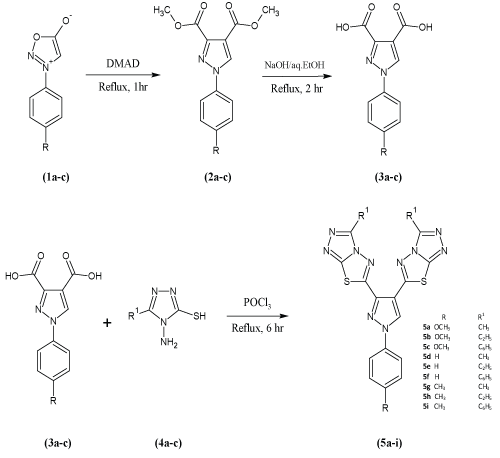
Scheme 2: Synthesis of bis-1, 2, 4-triazolo [3, 4-b]-1, 3, 4-thiadiazoles 5a-5i.
The structure of newly synthesized compounds was confirmed by 1H-NMR, IR, LCMS and C, H, N analysis. The absence of S-H and NH2 absorption bands confirmed the formation of product. The IR spectra of compound 5a-5i showed absorption peak at 1506-1516 cm-1 which is attributed to the stretching vibration of C=N. The characteristic absorption band due to C-S stretching was observed at 1070-1082 cm-1, whereas C-H stretching bands at 3059-3076 cm-1 associated with the aromatic rings were observed in all the molecules. 1H-NMR spectrum of compound 5e showed multiplet of methyl protons at δ, 1.36-1.39 ppm integrating for six protons. A multiplet due to four methylene protons was observed at δ, 3.05-3.17 ppm. The peaks due to aromatic protons were seen at δ, 7.62-7.66, 8.04 and 7.5-7.54 ppm pertain to ortho, meta and para protons of phenyl ring of pyrazole. While the proton of pyrazole ring displayed as a singlet at δ, 9.58 ppm. Further evidence for the formation of triazolo-thiadiazoles (5a-i) was obtained by recording mass spectra, where molecular ion peaks obtained were in consistence with their molecular formula.
All the newly synthesized triazolo-thiadiazoles (5a-i) were investigated for antibacterial and antifungal activity. Compound 5a showed good activity against Bacillus subtilis and compound 5g showed good activity against Pseudomonas aeruginosa. None of the compounds showed any considerable antifungal activity (Table 1).
| Compounds | Diameter of zone of inhibition (in mm ) at 100 µg/mL | |||||
| Antibacterial activities | Antifungal activities | |||||
| Gram positive bacteria | Gram negative bacteria | |||||
| S. aureus | B. subtilis | E. coli | P. aeruginosa | C. albicans | A. niger | |
| 5a | 11.5 ± 0.70 | 19.5 ± 0.70 | 12.5 ± 0.70 | 12 ± 1.4 | 10.5 ± 0.70 | 5 ± 0.00 |
| 5b | 10.5 ± 0.70 | 17.5 ± 0.70 | 14.5 ± 0.70 | 11 ± 1.4 | 9 ± 1.4 | 4.5 ± 0.70 |
| 5c | 15 ± 1.4 | 14 ± 0.0 | 9.5 ± 0.70 | 13 ± 1.4 | 9.5 ± 0.70 | 5.5 ± 0.70 |
| 5d | 13.5 ± 0.70 | 12.5 ± 0.70 | 14.5 ± 0.70 | 11 ± 0.0 | 10 ± 0.0 | 6 ± 0.0 |
| 5e | 16 ± 0.0 | 15.5 ± 2.1 | 12.5 ± 0.70 | 12.5 ± 0.70 | 10.5 ± 2.1 | 5.5 ± 0.70 |
| 5f | 14.5 ± 0.70 | 13.5 ± 0.70 | 15 ± 1.4 | 13.5 ± 0.70 | 9 ± 1.4 | 4.5 ± 0.70 |
| 5g | 12.5 ± 0.70 | 12 ± 0.0 | 14 ± 1.4 | 19.5 ± 0.70 | 9 ± 1.4 | 7 ± 0.0 |
| 5h | 15.5 ± 0.70 | 17 ± 1.4 | 14 ± 0.0 | 18.5 ± 0.70 | 5.5 ± 0.70 | 5 ± 0.0 |
| 5i | 14.5 ± 0.70 | 14.5 ± 0.70 | 10.5 ± 0.70 | 14 ± 1.4 | 9.5 ± 0.70 | 5.5 ± 0.70 |
| Ciprofloxacin | 23.5 ± 0.70 | 23.5 ± 0.70 | 22.5 ± 0.70 | 22.5 ± 0.70 | - | - |
| Fluconazole | - | - | - | - | 19.5 ± 0.70 | 22 ± 1.4 |
Table 1: Antibacterial and antifungal activity data of compounds 5a-5i.
All the compounds (5a-i) were found to have minimum binding energy ranging from -5.19 to -8.99 kJ/mol with antimicrobial Acinetobacter baumannii penicillin-binding protein target (PDB Code: 3UDI). Among the molecules tested for docking study, 1-p-tolyl-3,4-bis-(3-ethyl-[1,2,4] triazolo[3,4-b] [1,3,4]thiadiazol)-1H-pyrazole 5h showed minimum binding energy of -8.99 kJ/mol with ligand efficiency of -0.28. In the selected protein target maximum numbers of residues are nearer to the drug molecule and are hydrophobic in nature [24].
The ligand molecules, 5a, 5b and 5g revealed binding energy of -8.32, -8.13 and -7.83 kJ/mol, with ligand efficiency of -0.27, -0.25 and -0.26, respectively. The completely wrapping of the molecules by amino acid residues at the active site pocket region as displayed in Figure 1. In 5a, the oxygen atom of methoxy group displayed H-bonding interaction with the hydrogen atom of Ser434 at a distance of (2.174) Å, while the sulphur atom present in thiadiazolotriazole ring of the compound 5d, 5e and 5g was involved in the H-bonding with the active site of amino acid residue Tyr485 at a distance of (2.667), (2.872) and (2.816) Å, respectively as depicted in Figure 2. The docking study results showed that the molecules 5a-5h has good inhibition constant, vdW + H-bond + desolv energy with best RMSD value. The details of docked score results of the molecules are given in Table 2.
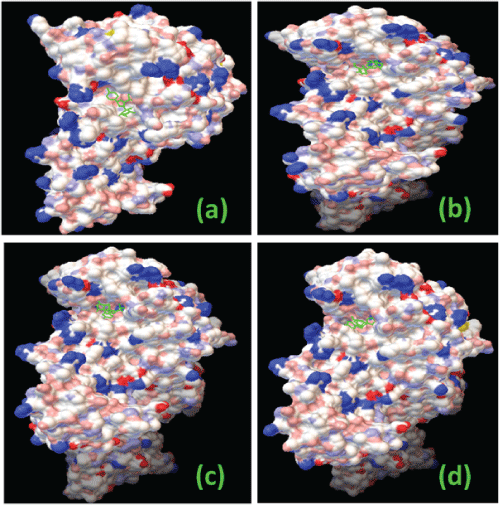
Figure 1: Figure (a), (b), (c) and (d) represents the enfolding of molecules 5a, 5b, 5g and 5h in the active site pocket of antimicrobial protein Acinetobacter baumannii penicillin-binding protein target (PDB Code: 3UDI).
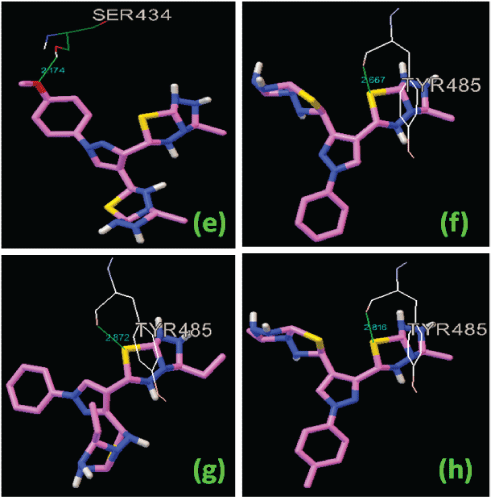
Figure 2: Figure (e), (f), (g) and (h) represents the H-bond interaction of ligand molecules 5a, 5d, 5e and 5g Acinetobacter baumannii penicillin-binding protein target (PDB Code: 3UDI).
| Compounds | Binding Energy | Ligand Efficiency |
Inhibition Constant | vdW+H-bond+ | No. of | Bonding residues | Bond Length |
| (kJ mol-1) | uM | desolv energy | H- bonds | (Å) | |||
| kcal/mol | |||||||
| 5a | -8.32 | -0.27 | 793.777 | -9.33 | 2 | 3UDI:A: SER434:HG | 2.174 |
| 5b | -8.13 | -0.25 | 1.11 | -9.16 | - | - | - |
| 5c | -7.19 | -0.18 | 5.41 | -8.83 | - | - | - |
| 5d | -7.39 | -0.25 | 3.81 | -7.88 | 1 | 3UDI: A: TYR485: O | 2.667 |
| 5e | -7.2 | -0.23 | 5.29 | -8.53 | 1 | 3UDI: A: TYR485: O | 2.872 |
| 5f | -6.35 | -0.16 | 22.06 | -7.96 | - | - | - |
| 5g | -7.83 | -0.26 | 1.81 | -8.29 | 1 | 3UDI: A: TYR485: O | 2.816 |
| 5h | -8.99 | -0.28 | 256.32 | -9.86 | - | - | - |
| 5i | -5.19 | -0.13 | 157.21 | -6.87 | - | - | - |
Table 2: The dock score results of triazolo-thiadiazoles (5a-i) with Acinetobacter baumannii penicillin-binding protein target (PDB Code: 3UDI).
The synthesized compounds showed DPPH scavenging activity varying from 76.38±0.32% to 18.01±0.15%, whereas standard drug BHA showed 88.33±0.33% inhibition. Compound 5d, 5e and 5h displayed 76.38±0.32%, 70.37±0.20% and 54.74±0.29% of activity closer to the standard employed. The percentage radical scavenging activity of the bis triazolothiadiazole has been described in Figure 3.
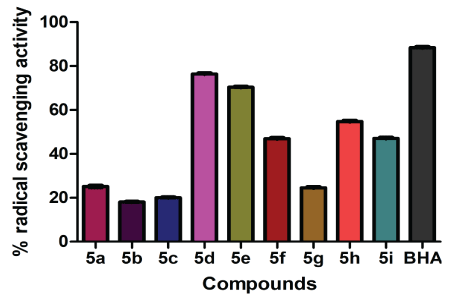
Figure 3: The DPPH radical scavenging activity of compounds 5a-5i.
A novel series of bis-[1,2,4]triazolo[3,4-b][1,3,4]thiadiazol1H-pyrazole were prepared by the cyclocondensation of 3-substituted-4-amino-5-mercapto-1,2,4-triazoles with 1-(aryl)- 1H-pyrazol-3,4-dicarboxylic acids. The newly synthesized compounds were characterized by spectral and analytical methods. Further molecular docking, antimicrobial and antioxidant studies were carried out. Compounds 5a and 5g showed significant antibacterial activity against Staphylococcus aureus and Pseudomonas aeruginosa. But none of the compound exhibited good antifungal activity. Compounds 5d, 5e and 5h showed good radical scavenging property
Authors are thankful to SAIF Punjab University, PURSE laboratory Mangalore University for providing the facility for spectral analysis. One of the authors Asma is grateful to UGC, New Delhi for Senior Research Fellowship.
Download Provisional PDF Here
Article Type: RESEARCH ARTICLE
Citation: Asma, Kalluraya B, Manju N, Chandra, Mahendra M, et al. (2018) Synthesis, Antimicrobial, Antioxidant and Molecular Docking Study of Some Novel Bis-1, 2, 4-Triazolo [3, 4-b]-1, 3, 4-Thiadiazoles. J Med Chem Drug Des 1(1): dx.doi.org/10.16966/2578-9589.105
Copyright: © 2018 Asma, et al. This is an open-access article distributed under the terms of the Creative Commons Attribution License, which permits unrestricted use, distribution, and reproduction in any medium, provided the original author and source are credited.
Publication history:
All Sci Forschen Journals are Open Access